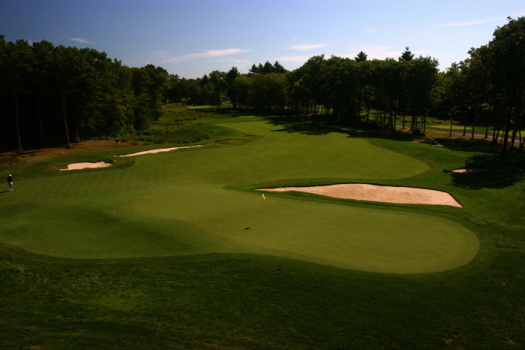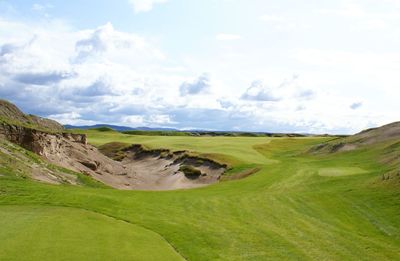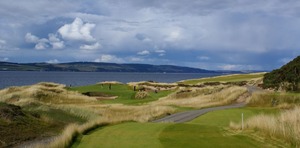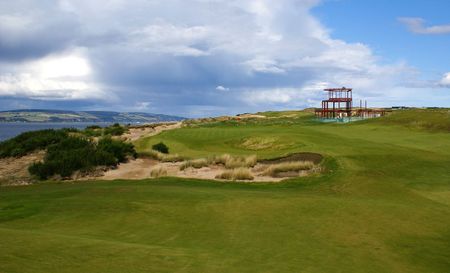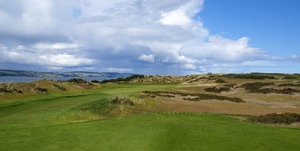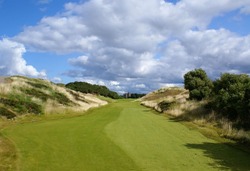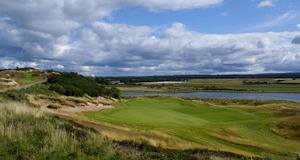When you come to think of it that is the secret of most of the great holes all over the world. They all have some kind of a twist. C.B. MACDONALD
Prairie Club Page Update
/ I've updated the Prairie Club page to include new articles from the New York Times on Valentine, the Omaha World-Herald on the project status and Gil Hanse's rendering of our Horse Course. Still to come over the fall and winter are two more videos and my treatise on Horse Golf.
I've updated the Prairie Club page to include new articles from the New York Times on Valentine, the Omaha World-Herald on the project status and Gil Hanse's rendering of our Horse Course. Still to come over the fall and winter are two more videos and my treatise on Horse Golf.
Castle Stuart Images Vol. 1
/With all of this gloom and doom I thought I'd share a few photos sent to me by John Kemp, an aspiring architect who worked on The Prairie Club's Horse Course project with us this summer. John was part of the crew that built Castle Stuart with Gil Hanse, Mark Parsinen and Jim Wagner. He recently played the course on what looked to be a stunning day and captured these shots. I don't know much about the holes, so hopefully John or someone else will chime in.
I believe this is the fourth hole. You know the drill, click on the images to see full screen versions.
“We didn’t want the green to look like it had been dropped from outer space in the backyard of Golf House"
/ Someone named Dave Fanucchi of the USGA, who apparently is part of the "new media" gang brought into restore Far Hills media relations order (but they are waiting to tell the golf media this!), sent this press release regarding Far Hills' new Gil Hanse-constructed putting course.
Someone named Dave Fanucchi of the USGA, who apparently is part of the "new media" gang brought into restore Far Hills media relations order (but they are waiting to tell the golf media this!), sent this press release regarding Far Hills' new Gil Hanse-constructed putting course.
USGA Museum’s The Pynes Putting Course Now Open to the Public
Far Hills, N.J. (Sept. 23, 2008) – The USGA Museum today opened The Pynes Putting Course, a 16,000-square-foot putting green that will allow visitors to test their skills using replicas of antique putters and balls from the late 19th and early 20th centuries.
The Pynes Putting Course will be open to visitors during regular Museum hours from early spring to late fall, weather permitting. The green fee is $5 with paid admission to the Museum and includes a souvenir square-mesh golf ball. Visitors will be able to use replicas of four classic putters ‑‑ such as Bob Jones’ famous Calamity Jane II ‑- to play the nine-hole course, which will be re-routed on a weekly basis.
Named for Evelyn and Percy Pyne, who lived on the grounds of the country estate that is now home to the United States Golf Association, The Pynes Putting Course was inspired by the world-renowned Himalayas putting green in St. Andrews, Scotland. That green, which has served as home to the Ladies’ Putting Club of St. Andrews since 1867, has long welcomed visitors from all over the globe.
“We hope that the experience of playing the putting course will increase visitors’ appreciation for golfers of the past and their skills,” said Rand Jerris, Director of the USGA Museum. “We hope there are some golfers who come and get hooked on the history of the game. It’s a place where families are welcome, and it may be the first time some visitors ever get to putt on a grass green.”
The green was designed by Philadelphia-based architect Gil Hanse, who also spent more than two days on a shaper to fashion the putting surface’s dramatic mounds and swales. USGA Green Section staffers Jim Moore and Dave Oatis oversaw the agronomic details of the green, which utilizes “Declaration,” a creeping bentgrass strain developed at Rutgers University with the assistance of USGA Green Section funding.Now, I don't like to pick on the USGA, but it would be nice if someone had proofread this so that it didn't have Gil Hanse spending two days on a shaper when he was actually on a bulldozer.
Gil also donated his services. Now, I would have advised against this since the USGA has $300 million in reserve (well...before the last few weeks they did). Still, it would have been nice for them to note that. It was also left out of David Shefter's otherwise excellent story on the new green, which also explains the fascinating process of making period putters and balls. There are also photo links there as well with images by John Mummert, including plenty of the construction process.
Querencia
/ Added to the lefthand column is a page devoted to Querencia where I will be helping Gil Hanse add a second course to the Los Cabos, Mexico development. There is an interview with Gil on the club site, a press release and my own site photos with descriptions of the land.
Added to the lefthand column is a page devoted to Querencia where I will be helping Gil Hanse add a second course to the Los Cabos, Mexico development. There is an interview with Gil on the club site, a press release and my own site photos with descriptions of the land. Another Castle Stuart Video
/The previous making of videos for Scotland's Castle Stuart resort are posted here, here, here and here. Volume 5 looks at the heather "chunking" work taking place. That does not sound very interesting, I know, but it's the best one yet, especially in showing how little about this natural looking links style course is shaping up to be quite...natural.Oh, and I have no idea who the fellow is who is talking throughout the video.
Castle Stuart Photos
/Posting will be light the next few days while I'm traveling (I know, I know, who goes out of town during Super Bowl week!?). In the mean time...
If you enjoyed the YouTube videos on the making of Scotland's Castle Stuart resort (here, here, here and here), below are some grow-in photos courtesy of Gil Hanse, who is co-designing the course with developer Mark Parsinen. You know the deal, just click on the photos to see them.

The 215-yard par-3 17th hole viewed from 16th green. Tee is to the right. 17th plays along clifftop into prevailing wind. Shots can be fed down from the left side while the direct line needs to carry bunkers. (click to enlarge image)

Manmade sand and heather ridge separating 16h green from 17th tee. (click to enlarge image)

View from left rough on 16th hole looking towards plateau green. 16th is a driveable 305 yard par 4. Hole plays downwind with slopes feeding balls from the right with a deep tightly mown hollow protecting the front left of the green. (click to enlarge image)

Short par-3 11th viewed from above on the 18th fairway. Tee is out of view to the left. Hole plays 145 yards. (click to enlarge image)

Par-5 6th hole, 580 yards, view of the approach taken from second shot area. Green is long and narrow and best approach from in front of or over the deep centerline fairway bunker. (click to enlarge image)

The driveable par-4 3rd. Plays in the opposite direction as the 16th. Green is on a peninsula jutting into the estuary. (click to enlarge image)

Clifftop par-4 7th hole, photo taken from leftside of the landing area. (click to enlarge image)

View of the approach to the par-5 second hole with dune bunkering along the coastline. (click to enlarge image)
Deutsche Bank Wrap Up
/“Some of the holes, you look at them and half the hole has been changed. That side has, but this side doesn’t have the same look,” Waugh said. “The course plays differently, more strategically because of Gil’s work.”Jim McCabe has more from a jubiliant Waugh, comments from Waugh that make it quite clear how little schedule tinkering will go on for 2008, and this update on the much talked about fourth hole:
The fourth hole, which went from a dogleg 435-yarder to a 298-yard par-4, was the hole the players least liked, Waugh reported. The new hole, driveable for virtually all of the players, was much better received.
Among others, Phil Mickelson went 2, 3, 5, 3 on the hole, picking up three strokes on Tiger Woods, who went 6, 2, 4, 4. Because it provides wild swings in scoring, officials are discussing the possibility of setting up new stands behind the green and making it one of the focus holes.
The hope is to continue to modify the course, although now it becomes merely fine-tuning.
“Gil is an artist. Brad is, too. You just let them go paint the picture,” Waugh said.
When all was said and done, the much talked-about par-4 fourth - a 298-yarder that had plenty of skeptics - held its own. No doubt, players took aim and plenty drove the green - 134 of them in four days. Five players made eagles as the hole played to a field average of 3.714 to rank 16th. But as a testament to the devilish nature of the hole, of the top eight players on the leaderboard at the start of the day, only Mickelson made birdie in the final round. Crunching some numbers after 374 scores had been recorded over four days:Cameron Morfit says the Mickelson issue is simple: he hasn't played well at Cog Hill.
Woods never did birdie it. He had a three-putt par yesterday, a par in Round 3, an eagle Saturday, and that unforgettable double bogey thanks to three bunker shots Friday.
Tom Pernice was the only player of the 75 who made the cut to play the hole over par. He made the championship's only triple bogey, then followed with three pars.
Mickelson played it in 3 under.
Sergio Garcia had four pars.
Weighing Options On TPC Boston's 4th
/As expected, the Hanse-Faxon-Wagner redesign of TPC Boston's 4th hole is generating the most discussion, fueled in part by the possibility that officials may play the 356-yard tee for two rounds. Since that tee was never intended to be used for Deutsche Bank tournament play, it appears the Tour officials have decided to play it at around 300 yards all four days.
Until we see actual tournament play, we won't know which option players will most often chose to take. Just from observing some play on it, the hole looks like a Redan merged with elements of Riviera's 10th. It seems that a few will lay-up with a four or five iron, most will hit three wood at the front opening or into the front bunker, while some will take driver and err on the long side of the green.
A few images, starting with the view from the tee.
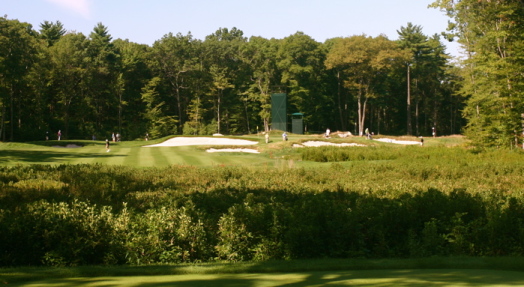
And the view from the left center of the fairway...
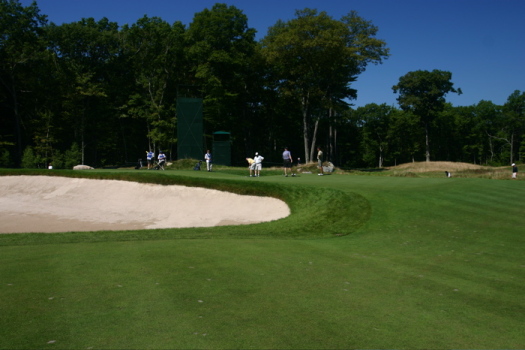
And the view from the right center, which is the ideal layup angle.
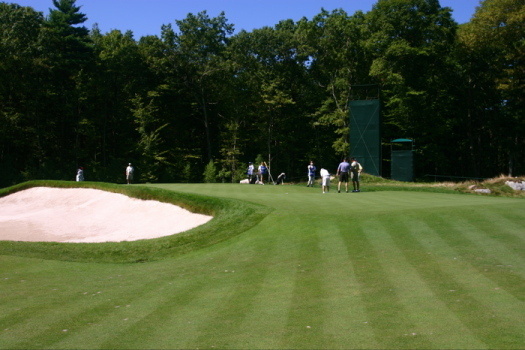
Finally, the rear view which flattens out some of the neat features over the green (fall off, bumps, etc...) that may make the player driving it long think twice. There are some small mounds meant to look like the old style New England bumps that are often found in this area when crews would bury large rocks instead of trying to cart them off property.
